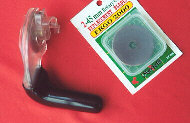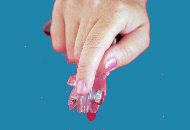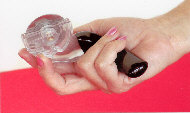Neu erschienen in 2002 ist der ungewöhnlich aussehende Ergo Cutter 2000 eines US-Herstellers.
Lassen Sie sich aber bitte von der ungewöhnlichen Optik nicht täuschen! Wir haben getestet und waren verblüfft. Zu praktisch allen auf dem Markt angebotenen Modellen ist hier ein grosser Unterschied dadurch zu bemerken, dass sich dieses Modell sozusagen komplett mit der Hand umschliessen lässt. Dadurch wird der Druck der Hand, der beim Schneiden erforderlich ist, direkt auf die Klinge übertragen.



| Ansicht von oben | Handhabung: von der Hand umschlossen | Ansicht von unten |
Interessant ist der Klingenschutz: er schwenkt, sobald man beim Schneiden den Untergrund berührt automatisch weg und wird nach dem Schneidevorgang mit einem Finger wieder in Position gebracht.
Bei Interesse mailen Sie doch einfach an info@pdpm.de
Wir stehen im Kontakt mit dem Hersteller!
Auszug aus einem Text des Herstellers:
1. The Ergo 2000 Rotary Cutter is NOT like any rotary cutter on the market.
2. The Ergo Cutter is DESIGNED AND ENGINEERED TO WORK COMPLETELY DIFFERENT.
3. With the Ergo Cutter you have to realize there is a different cutting technique.
4. The Ergo Cutter uses a horizontal, parallel pushing technique.
5. The Ergo Cutter uses ALL 16 pressures points of the hand and evenly distributes over the entire cutter, therefore uses less exertion when cutting.
6. The Ergo Cutter is designed for the forefinger to follow the contour of the blade guard and rest comfortable upon it. No stress should be placed on the forefinger when cutting.
7. The Ergo Cutter is designed to sit in the back of the palm of your hand, with the three fingers then wrapped around the handle, the thumb sits on the opposite side of the cutter in the thumb rest. HOWEVER, not all hands are the same size so think of how you would grab a bicycle handle and that would be the same kind of a hold you would have on the Ergo Cutter.
TO TEST PROPER HOLD: To test if you are holding the Ergo properly grab the cutter as the description above indicates and roll the cutter forward on the cutting mat, if the "w" shape finger lever hits any of your three finger on the handle while you roll it open, then you have the Ergo Cutter placed to far forward in the palm of your hand. Just scoot it back an inch or so. The idea is to make it comfortably sit in the palm of your hand. If it rest comfortably you are ready to cut. Also, when you are holding the cutter in a comfortable position, you must now think about the positioning of the blade, do you have the the blade exposed as much as possible and sitting in a parallel position to the cutting mat?
DO NOT HOLD THE ERGO CUTTER VERTICAL. If you do, then you will only be cutting with a small portion of the blade, therefore you will have to exert so much pressure to cut, you will actually begin to arode the metal fibers away on the inside diameter of the blade, and once you do that the screw catches on the metal filings and begins to unscrew the bolt. You must keep the blade parallel so 100% of the usable blade of the cutter will do the cutting. If you keep your hand horizontal when cutting then all the 16 pressure points of the hand are being used and you will be amazed at how little pressure you will need to use when you cut. Also because you cut in a horizontal hand position, you can actually cut as good sitting down as you do standing up. I have had testimonies now from women who have said they have cut as much as 20 layers at a time using our Ergo Cutter, without using a lot of pressure.
I have observed however, that I have to make sure that the user realizes there is a very different cutting technique. After I take the time to explain the differences I show literally how to hold it in their hand. And I simple teach the " how to's"
1. Keep the cutter parallel to the cutting mat.
2. Keep the hand horizontal when cutting.
3. Keep the shoulder down and in a relaxed position.
4. Push the Ergo Cutter instead of Pressing down upon it. Once you do these things you begin to see that the Ergo Cutter is truly 100% Ergonomic. There is no stress on shoulder, no stress on the forefinger, no stress on the wrist.